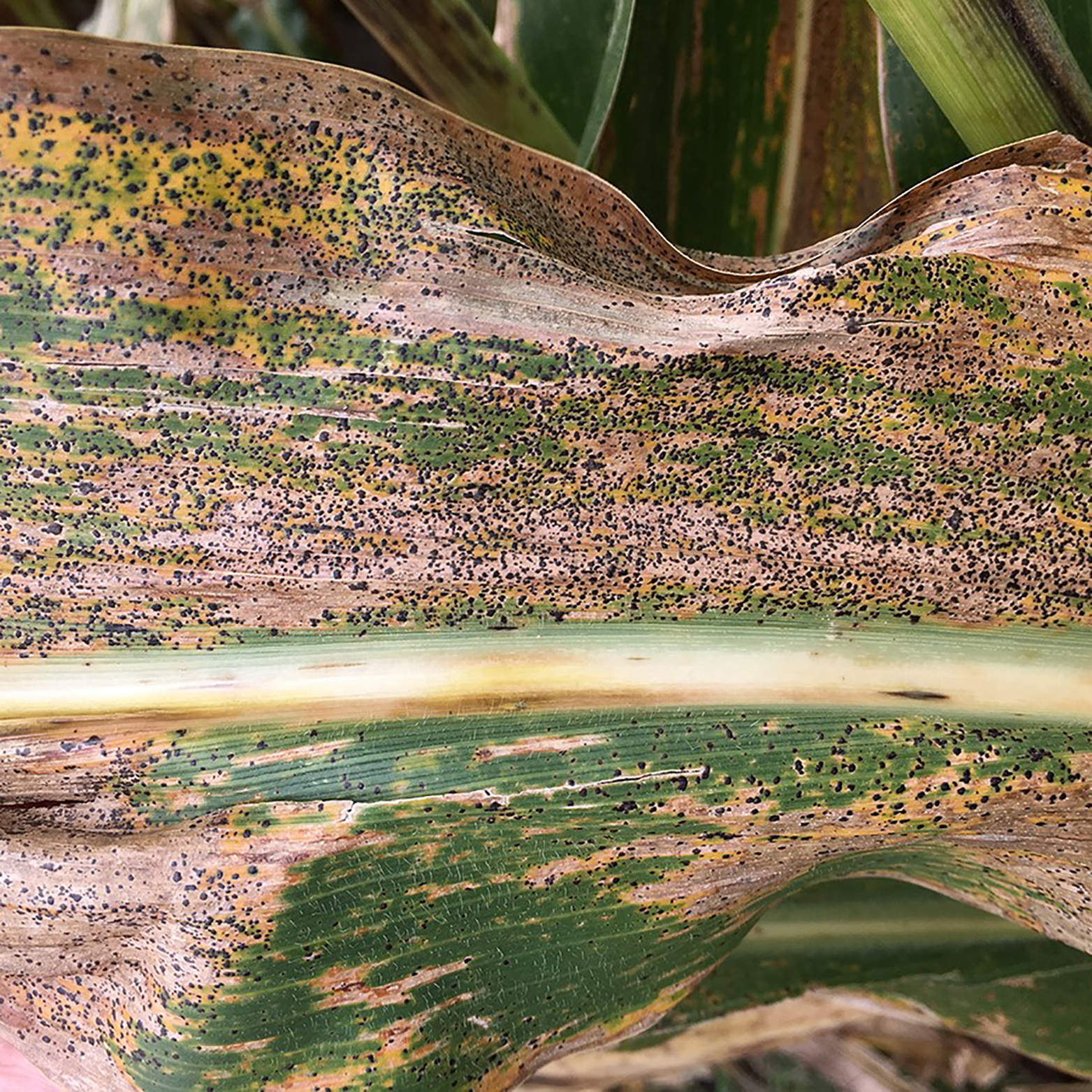2025 Corn Disease Outlook

Physoderma stalk rot, image courtesy of DTN/Progressive Farmer
Physoderma stalk rot, image courtesy of DTN/Progressive Farmer
You’ve likely watched the bushels on your combine yield monitor whirl downward as a patch or field area of unhealthy corn plants stream into the header.
Unfortunately, the residue spewed out the back of the combine in 2024 and overwintered in the field can cause more significant harm this year, especially if the weather aligns to create a disease triangle.
Existence of a disease requires the interaction of a susceptible host, virulent pathogen and an environment favorable to disease development. Spring and summer winds can further spread overwintering Corn Belt leaf disease like tar spot, northern leaf blight and gray leaf spot.
If further unlucky, like when 2024 Hurricane Beryl pushed southern air into the Corn Belt, southern rust spores can invade the nation’s cornfields and steal an estimated 244 million bushels.
Yet yield loss due to southern rust pales in comparison to these diseases (2024 estimated yield loss data) in cornfields across the United States:
It’s always good to review last year’s disease history and conditions in each field. For seedling diseases, it’s all about understanding wet areas for root rots or sandy soils where nematodes can thrive. For summer foliar diseases, examine which fields have more low spots, river bottoms or side hills where disease outbreaks occur more frequently.
“Most corn hybrids come with good seed treatment protection against early diseases. But be cautious, because they are not a silver bullet,” says Alison Robertson, plant pathologist at Iowa State University. “If planting early into cold, wet soils that slow germination, you should only plan for 10 to 14 days of protection. After that, fusarium and pythium can weaken or kill growth under cool and wet conditions.”
If early season diseases take hold in the spring, they also can wreak further havoc before harvest, causing crown and stalk rot. Robertson says University of Nebraska research has preliminary data that suggests slower-developing plants (by one to two growth stages) have a greater risk of crown rot. The best remedy is to avoid early planting into cold, moist soils that lead to uneven emergence.

Tar spot symptoms, image courtesy of DTN/Progressive Farmer
Tar spot and corn stunt are two diseases causing more concern among Corn Belt farmers. Tar spot has been in the United States for a decade and is now surviving in corn residue across the Corn Belt (see map).
In Iowa, Robertson says, tar spot is everywhere, but severity depends on weather conditions during the growing season.
“It’s more severe in southeast Iowa due to six or seven years of inoculum buildup,” Robertson says. “We’ve also learned that crop rotation doesn’t impact corn planted in soybean residue, because spores can blow in from nearby cornfields.”
Growers observed corn stunt, while not new to southern United States and Latin American corn growers, farther north in 2024 perhaps due to warming trends and movement of the corn leafhopper. Above-normal temperatures in 2024 aided its spread from Texas into the Great Plains — even carried by winds as far north as New York.
Bacterial leaf diseases like Goss’s wilt and bacterial leaf streak can always be a problem if planting susceptible hybrids. Robertson encourages farmers to review hybrid disease resistance.
It’s important to scout early, paying attention to field areas prone to disease. While assessing stand counts, be sure to examine plant growth uniformity. “With corn, we want every plant to look identical in the field since late-emerging plants can easily turn into weeds by not developing an ear and may be more susceptible to disease and insects,” Robertson says.
For foliar diseases like tar spot, northern leaf blight, gray leaf spot, and southern rust, standard scout timing is growth stage V16 to V18 when normal rainfall, higher humidity, and morning dew conditions favor leaf diseases. Tar spot can show up early around V7 to V8, but higher temperatures in midsummer can slow development until mid grain fill. Watch regional updates to determine southern rust pressure from the South.
For tar spot, watch prediction models like the mobile app Tarspotter and other disease models offered by various agribusinesses. “I tell farmers not to give up on these models, just like they rely on weather prediction, which these disease models use. They’re not 100% accurate, but they certainly help,” Robertson says.
According to Robertson’s data over 20 years, farmers can apply one foliar fungicide application between tassel and when silks are turning brown to control foliar diseases.
“Given current grain prices and input costs, one application provides the best protection against yield loss,” she says. “Download our latest 2025 fungicide efficacy recommendations at CropProtectionNetwork.org.”
Any farmer that is concerned about diseases in corn should start by planting disease-resistant hybrids, Robertson stresses. “Foliar fungicides should only be used as a backup if it looks like a bad disease year. Our hybrids have pretty good resistance, and in most cases, you probably don’t even need that fungicide.”
Content provided by DTN/The Progressive Farmer
Find expert insights on agronomics, crop protection, farm operations and more.